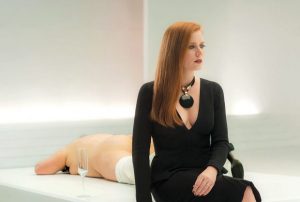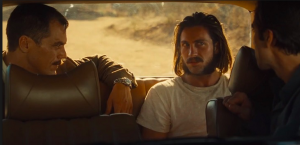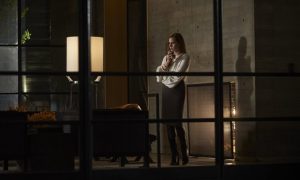 Title: Nocturnal Animals | Rated: R | Runtime: 117 min | Theaters limited (expanding)
Title: Nocturnal Animals | Rated: R | Runtime: 117 min | Theaters limited (expanding)
Storytelling for cinema is a difficult art to master since there’s so much to look out for. The hook must be gripping, and the characters need to be compelling. Once you have those, you’d think the script is fine, but that’s just the tip of the iceberg. The journey, the proceedings must be worth the investment, and that’s when you take into account character arcs, relationships, themes, and how that story should be told. At the end of the day, the story matters most, which means that the audience must care. With his sophomoric feature Nocturnal Animals, writer-director Tom Ford – yes, the fashion designer – definitely proves himself to be a tremendous visual stylist, though he doesn’t quite breathe proper life into what is an interesting yet dispassionate story.
 An adaptation of Austin Wright’s novel Tony and Susan (which this writer hasn’t read), the film, while intriguing, holds the viewer at bay to a fault. After a mesmerizing opening credits sequence, it introduces art gallery owner Susan (Amy Adams), who receives a manuscript of a novel written by her estranged ex-husband Edward (Jake Gyllenhaal) titled Nocturnal Animals, which she begins reading. The story soon intertwines with a dramatization of the novel – which follows a man named Tony (Gyllenhaal) seeking revenge on a trio of troublemakers who confronted him and his family – as well as flashbacks revealing Edward and Susan’s past. There are three storylines operating here, and Tony’s journey is easily the most interesting, though it’s rather hilarious how Susan describes Nocturnal Animals as beautiful because it’s a dime novel at best. It goes to show that the dramatization of the novel relies very much on the visuals – in this case, Susan’s imagination – to be compelling, and indeed, they elevate its proceedings despite the whole thing ultimately being inconsequential (a common trouble with stories within stories). When the film takes us out of Tony’s narrative to address the present storyline, it’s frustrating since Susan and the other characters are unsympathetic, and their robotic actions push the whole film further and further into cynicism. This, combined with the very clunky and on the nose dialogue, makes emotional investment in the present storyline and its characters difficult. The theme of emasculation connects all three storylines, and seeing how it unfolds in each one is arguably the film’s most fascinating feature.
An adaptation of Austin Wright’s novel Tony and Susan (which this writer hasn’t read), the film, while intriguing, holds the viewer at bay to a fault. After a mesmerizing opening credits sequence, it introduces art gallery owner Susan (Amy Adams), who receives a manuscript of a novel written by her estranged ex-husband Edward (Jake Gyllenhaal) titled Nocturnal Animals, which she begins reading. The story soon intertwines with a dramatization of the novel – which follows a man named Tony (Gyllenhaal) seeking revenge on a trio of troublemakers who confronted him and his family – as well as flashbacks revealing Edward and Susan’s past. There are three storylines operating here, and Tony’s journey is easily the most interesting, though it’s rather hilarious how Susan describes Nocturnal Animals as beautiful because it’s a dime novel at best. It goes to show that the dramatization of the novel relies very much on the visuals – in this case, Susan’s imagination – to be compelling, and indeed, they elevate its proceedings despite the whole thing ultimately being inconsequential (a common trouble with stories within stories). When the film takes us out of Tony’s narrative to address the present storyline, it’s frustrating since Susan and the other characters are unsympathetic, and their robotic actions push the whole film further and further into cynicism. This, combined with the very clunky and on the nose dialogue, makes emotional investment in the present storyline and its characters difficult. The theme of emasculation connects all three storylines, and seeing how it unfolds in each one is arguably the film’s most fascinating feature.
 Ford has assembled quite the cast here, and all of the performances are at the very least serviceable, though there are a handful who shine. Through the flashbacks and the present storyline, Adams displays two sides to her character, and she handily imparts both the warmth of her past self and the numbness of her current self. One can certainly wish that Ford gives her more to do as present Susan, as Adams seems to be suffocated by the aforementioned stilted dialogue. Gyllenhaal handles Edward’s sensitivity with great care, though it’s the role of Tony where he excels, encapsulating grief and helplessness till he’s pressed to cathartic explosion. Indeed, the cast members playing characters in the Nocturnal Animals novel fare quite well, as they heighten that story. Michael Shannon injects a sardonic yet charming sense of humor into the role of the cool-headed and world-weary Detective Andes. The biggest surprise here is Aaron Taylor-Johnson as lead troublemaker Ray Marcus, as he absolutely nails the character’s contempt and wretchedness while baring his charisma. As Tony’s wife Laura, Isla Fisher is good at being the voice of reason and hits all of her emotional notes. Armie Hammer, Laura Linney, Jena Malone, Andrea Riseborough, and Michael Sheen round out the cast, and they’re fine, though it’s arguable that their mere cameos are wastes of their talent.
Ford has assembled quite the cast here, and all of the performances are at the very least serviceable, though there are a handful who shine. Through the flashbacks and the present storyline, Adams displays two sides to her character, and she handily imparts both the warmth of her past self and the numbness of her current self. One can certainly wish that Ford gives her more to do as present Susan, as Adams seems to be suffocated by the aforementioned stilted dialogue. Gyllenhaal handles Edward’s sensitivity with great care, though it’s the role of Tony where he excels, encapsulating grief and helplessness till he’s pressed to cathartic explosion. Indeed, the cast members playing characters in the Nocturnal Animals novel fare quite well, as they heighten that story. Michael Shannon injects a sardonic yet charming sense of humor into the role of the cool-headed and world-weary Detective Andes. The biggest surprise here is Aaron Taylor-Johnson as lead troublemaker Ray Marcus, as he absolutely nails the character’s contempt and wretchedness while baring his charisma. As Tony’s wife Laura, Isla Fisher is good at being the voice of reason and hits all of her emotional notes. Armie Hammer, Laura Linney, Jena Malone, Andrea Riseborough, and Michael Sheen round out the cast, and they’re fine, though it’s arguable that their mere cameos are wastes of their talent.
 Under Ford’s direction, the film is beautifully crafted. Everything in the frame feels like a deliberate choice from the filmmaker, from the fact that both Susan and Laura both have red hair to a crucifix necklace that appears in both the present storyline and the fictional world of Nocturnal Animals. He, along with cinematographer Seamus McGarvey, compose the human form in breathtaking and stark images, and the extensive use of close-up shots highlight Ford’s attention to detail. Editor Joan Sobel ratchets up the tension brilliantly in several sequences from Tony’s story; with horror and thriller films, a tense sequence tends to denote sudden actions with cuts, and Sobel subverts that practice here, as she uses multiple cuts to trick us into thinking that something will happen, effectively building suspense. Production designer Shane Valentino’s choice of locations, from Susan’s minimalist home to a dilapidated shack, reflect not just the characters’ emotions, but their moralities (or lack thereof). It shouldn’t be a surprise that the film’s costumes – designed by Arianne Phillips – are gorgeous, and Ford ensures that his characters are dressed very well, especially those in the present storyline, for they seem to move as though they’re walking down a fashion runway. Abel Korzeniowski’s haunting and melodramatic score harkens back to classical thiller films, and to merely hear his weeping strings prompts a rush of emotions.
Under Ford’s direction, the film is beautifully crafted. Everything in the frame feels like a deliberate choice from the filmmaker, from the fact that both Susan and Laura both have red hair to a crucifix necklace that appears in both the present storyline and the fictional world of Nocturnal Animals. He, along with cinematographer Seamus McGarvey, compose the human form in breathtaking and stark images, and the extensive use of close-up shots highlight Ford’s attention to detail. Editor Joan Sobel ratchets up the tension brilliantly in several sequences from Tony’s story; with horror and thriller films, a tense sequence tends to denote sudden actions with cuts, and Sobel subverts that practice here, as she uses multiple cuts to trick us into thinking that something will happen, effectively building suspense. Production designer Shane Valentino’s choice of locations, from Susan’s minimalist home to a dilapidated shack, reflect not just the characters’ emotions, but their moralities (or lack thereof). It shouldn’t be a surprise that the film’s costumes – designed by Arianne Phillips – are gorgeous, and Ford ensures that his characters are dressed very well, especially those in the present storyline, for they seem to move as though they’re walking down a fashion runway. Abel Korzeniowski’s haunting and melodramatic score harkens back to classical thiller films, and to merely hear his weeping strings prompts a rush of emotions.
Nocturnal Animals is a pretty and admirable effort from Ford. To say that it’s an example of style over substance holds some merit but would also be a hasty generalization. The film is highly stylized for sure and more notable than the story itself, but the intertwined narrative has an interesting idea to run with and does so, even if it is hard to truly care about all of its contents.
Rating: 3.5/5.0
* Photos courtesy of Focus Features
